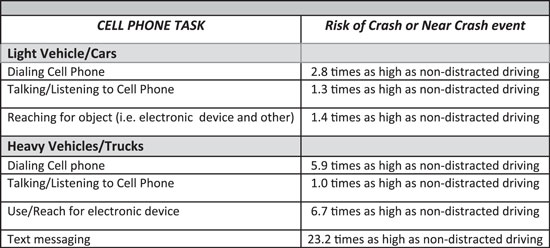|
|
CELL PHONE USE AND DRIVING DISTRACTION New Data from Virginia Tech Transportation Institute Provides Insight into Cell Phone Use and Driving Distraction Blacksburg,Va., July 27, 2009 – Several large scale, naturalistic driving studies (using sophisticated cameras and instrumentation in participants’ personal vehicles) conducted by the Virginia Tech Transportation Institute (VTTI), provide a clear picture of driver distraction and cell phone use under real world driving conditions. Combined, these studies continuously observed drivers for more than 6 million miles of driving.A snapshot of risk estimates from these studies is shown in the table below. “Given recent catastrophic crash events and disturbing trends, there is an alarming amount of misinformation and confusion regarding cell phone and texting use while behind the wheel of a vehicle. The findings from our research at VTTI can help begin to clear up these misconceptions as it is based on real world driving data. We conduct transportation safety research in an effort to equip the public with information that can save lives,” says Dr.Tom Dingus, director of the Virginia Tech Transportation Institute. In VTTI’s studies that included light vehicle drivers and truck drivers, manual manipulation of phones such as dialing and texting of the cell phone lead to a substantial increase in the risk of being involved in a safety critical event (e.g., crash or near crash). However, talking or listening increased risk much less for light vehicles and not at all for trucks.Text messaging on a cell phone was associated with the highest risk of all cell phone related tasks.
Eye glance analyses were conducted to assess where drivers were looking while involved in a safety critical event and performing cell phone tasks.The tasks that draw the driver’s eyes away from the forward roadway were those with the highest risk. Several recent high visibility trucking and transit crashes have been directly linked to texting from a cell phone.VTTI’s research showed that text messaging, which had the highest risk of over 20 times worse than driving while not using a phone, also had the longest duration of eyes off road time (4.6 s over a 6 s interval).This equates to a driver traveling the length of a football field at 55 mph without looking at the roadway.Talking/listening to a cell phone allowed drivers to maintain eyes on the road and were not associated with an increased safety risk to nearly the same degree. Recent results from other researchers using driving simulators suggest that talking and listening is as dangerous as visually distracting cell phone tasks. The results from VTTI’s naturalistic driving studies clearly indicate that this is not the case. For example, talking and listening to a cell phone is not nearly as risky as driving while drunk at the legal limit of alcohol. Recent comparisons made in the literature greatly exaggerate the cell phone risk relative to the very serious effects of alcohol use, which increases the risk of a fatal crash approximately seven times that of sober driving. Using simple fatal crash and phone use statistics, if talking on cell phones was as risky as driving while drunk, the number of fatal crashes would have increased roughly 50% in the last decade instead of remaining largely unchanged. These results show conclusively that a real key to significantly improving safety is keeping your eyes on the road. In contrast, “cognitively intense” tasks (e.g., emotional conversations, “books on tape”, etc.) can have a measurable effect in the laboratory, but the actual driving risks are much lower in comparison.
VTTI’s recommendations (based on findings from research studies)
The Disconnect Between Naturalistic and Simulator Research It is important to keep in mind that a driving simulator is not actual driving. Driving simulators engage participants in tracking tasks in a laboratory. As such, researchers that conduct simulator studies must be cautious when suggesting that conclusions based on simulator studies are applicable to actual driving. With the introduction of naturalistic driving studies that record drivers (through continuous video and kinematic sensors) in actual driving situations, we now have a scientific method to study driver behavior in real world driving conditions in the presence of real world daily pressures. As such, if the point of transportation safety research is to understand driver behavior in the real world (e.g., increase crash risk due to cell phone use), and when conflicting findings occur between naturalistic studies and simulator studies, findings from the real world, and not the simulator world, must be considered the gold standard. It is also critical to note that some results of recent naturalistic driving studies, including those highlighted here as well as others (e.g., Sayer, Devonshire and Flanagan, 2007) are at odds with results obtained from simulator studies. Future research is necessary to explore the reasons why simulator studies sometimes do not reflect studies conducted in actual driving conditions (i.e., the full context of the driving environment). It may be, as Sayer, Devonshire and Flanagan (2007) note, that controlled investigations cannot account for driver choice behavior and risk perception as it actually occurs in real world driving. If this assessment is accurate, the generalizability of simulator findings, at least in some cases, may be greatly limited outside of the simulated environment. NOTE: Dr. Rich Hanowski, Director of the Center for Truck and Bus Safety at VTTI, will be presenting the results of his study directed at Driver Distraction in Commercial Motor Vehicle Operations, at the First International Conference on Driver Distraction and Inattention in Gothenburg, Sweden, September 28 29, 2009. For references please refer to article at: www.vtti.vt.edu/PDF/7-22-09-VTTIPress_Release_Cell_phones_and_Driver_Distraction.pdf
© 2015 TLC Magazine Online, Inc. |
